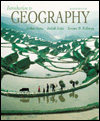 |  Introduction to Geography, 8/e Arthur Getis,
San Diego State University
Judith Getis
Jerome D. Fellmann,
University of Illinois, Urbana-Champaign
Introduction
Objectives:After reading and studying this chapter you should be able to:
1.Understand what is meant by the term "geography" and why it is important to be geographically literate. |
 |  |  | 2.
Understand how the field of geography evolved.
|
 |  |  | 3.
Recognize the types of employment available to professionally trained geographers.
|
 |  |  | 4.
Know the six questions that geographers ask to understand the nature of geography.
|
 |  |  | 5.
Understand that size and scale can affect the interpretation of geographic phenomena.
|
 |  |  | 6.
To be able to identify places in terms of their absolute and relative location. |
 |  |  | 7.
Distinguish between physical and cultural landscapes and how humans can change the attributes of a place.
|
 |  |  | 8.
Know what is meant by accessibility, connectivity, and distance decay when concerned with the interaction among places.
|
 |  |  | 9.Classify regional descriptions as being either "formal" or "functional." |
 |  |  | 9.
Identify the four traditions of geography, and know each of their approaches to geographic understanding.
|
|



 2002 McGraw-Hill Higher Education
2002 McGraw-Hill Higher Education